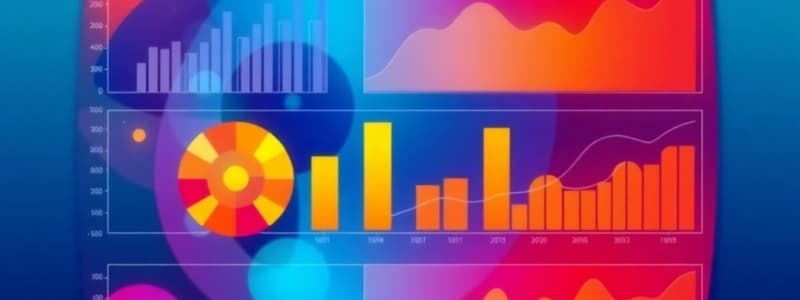Podcast
Questions and Answers
What is the primary focus of scenario analysis in business analytics?
What is the primary focus of scenario analysis in business analytics?
- Exploring different 'what-if' scenarios to evaluate potential impacts (correct)
- Reducing operational costs through standard methods
- Implementing immediate actions based on predictions
- Maximizing revenue without considering risks
Which technique is NOT typically associated with business analytics?
Which technique is NOT typically associated with business analytics?
- Linear programming
- Emotional intelligence assessment (correct)
- Genetic algorithms
- Simulated annealing
What should decision-making in business analytics primarily be based on?
What should decision-making in business analytics primarily be based on?
- Previous successful strategies only
- Market trends exclusively
- A mix of quantitative and qualitative data (correct)
- Intuition and personal experience
Which of the following is a primary benefit of utilizing business analytics in supply chain management?
Which of the following is a primary benefit of utilizing business analytics in supply chain management?
After implementing a chosen solution in business analytics, what is the next step?
After implementing a chosen solution in business analytics, what is the next step?
What role does market basket analysis primarily serve in a retail environment?
What role does market basket analysis primarily serve in a retail environment?
Which of the following describes the importance of stakeholder involvement in decision-making?
Which of the following describes the importance of stakeholder involvement in decision-making?
How does fraud detection analytics contribute to organizational security?
How does fraud detection analytics contribute to organizational security?
In what way does business analytics support customer relationship management (CRM)?
In what way does business analytics support customer relationship management (CRM)?
What is one of the significant uses of business analytics in product development?
What is one of the significant uses of business analytics in product development?
Which type of data includes social media posts and customer reviews?
Which type of data includes social media posts and customer reviews?
Which tool is primarily known for its data visualization capabilities in business analytics?
Which tool is primarily known for its data visualization capabilities in business analytics?
What role does business analytics play in the finance sector?
What role does business analytics play in the finance sector?
Which of the following is NOT a feature of the Board analytics tool?
Which of the following is NOT a feature of the Board analytics tool?
What type of structured data might you expect to find in a typical database?
What type of structured data might you expect to find in a typical database?
What is the primary purpose of tracking metrics and KPIs after implementation?
What is the primary purpose of tracking metrics and KPIs after implementation?
Which aspect is least likely to contribute to the continuous improvement of decision-making in business analytics?
Which aspect is least likely to contribute to the continuous improvement of decision-making in business analytics?
What key information should be updated in the database after a decision is made?
What key information should be updated in the database after a decision is made?
Why is it important to keep data current and relevant in business analytics?
Why is it important to keep data current and relevant in business analytics?
What is the role of a feedback loop in business analytics?
What is the role of a feedback loop in business analytics?
Flashcards
Business Analytics
Business Analytics
A tool used to boost a company's profits and productivity while cutting costs.
Supply Chain Optimization
Supply Chain Optimization
Improving supply chains by analyzing data like inventory, suppliers, and logistics.
Fraud Detection
Fraud Detection
Using advanced tools to identify and prevent fraud.
Market Basket Analysis
Market Basket Analysis
Signup and view all the flashcards
CRM (Customer Relationship Management)
CRM (Customer Relationship Management)
Signup and view all the flashcards
Structured Data
Structured Data
Signup and view all the flashcards
Semi-Structured Data
Semi-Structured Data
Signup and view all the flashcards
Unstructured Data
Unstructured Data
Signup and view all the flashcards
Business Analytics Tools (Examples)
Business Analytics Tools (Examples)
Signup and view all the flashcards
Business Analytics in Finance
Business Analytics in Finance
Signup and view all the flashcards
Business Analytics Goal
Business Analytics Goal
Signup and view all the flashcards
Optimization Techniques
Optimization Techniques
Signup and view all the flashcards
Scenario Analysis
Scenario Analysis
Signup and view all the flashcards
Data-Driven Decision-Making
Data-Driven Decision-Making
Signup and view all the flashcards
Solution Implementation
Solution Implementation
Signup and view all the flashcards
Implementation Planning
Implementation Planning
Signup and view all the flashcards
Monitoring Results
Monitoring Results
Signup and view all the flashcards
Feedback Loop
Feedback Loop
Signup and view all the flashcards
Data Update
Data Update
Signup and view all the flashcards
Decision Result Updates
Decision Result Updates
Signup and view all the flashcards
Study Notes
Business Analytics Unit 1
- Business analytics is the process of using data to make better decisions. Data management, visualization, predictive modeling, data mining, forecasting, and optimization are used tools to create insights
- Business analytics can be applied to various areas, including sales, marketing, finance, operations, and customer service, to help identify trends, patterns, and correlations and optimize business processes
- There are four types of business analytics:
- Descriptive analytics: Analyzes historical data to understand past performance. It interprets historical data to gain insights, and is used alongside predictive and prescriptive analytics. Common insights include year-over-year comparisons, user numbers, revenue per investor, and KPIs for better understanding of the current state of business
- Examples include summarizing past events, exchanging data, social media usage, and reporting general trends.
- Diagnostic analytics: Focuses on past performance to understand why something happened. Uses drill-downs, data mining, data discovery, and correlations to solve driving factors
- Examples include examining market demand, identifying technical issues, explaining customer behavior, and improving organization culture
- Predictive analytics: Focuses on forecasting future outcomes by answering "what is likely to happen?" Uses historical data, machine learning algorithms, and statistical models to predict future trends and behaviors
- Examples include forecasting future outcomes (sales or demand), predicting credit risk, and anticipating customer churn or retention rates
- Prescriptive analytics: Generates information to understand similar future situations to past performance. Uses tools, statistics, and machine learning to uncover relevant data to make future predictions.
- Examples include tracking fluctuating product prices, price modeling, and suggesting the best course of action
- Descriptive analytics: Analyzes historical data to understand past performance. It interprets historical data to gain insights, and is used alongside predictive and prescriptive analytics. Common insights include year-over-year comparisons, user numbers, revenue per investor, and KPIs for better understanding of the current state of business
Terminology in Business Analytics
- Business analytics involves collecting, organizing, analyzing, and interpreting data to make informed business decisions. It utilizes techniques such as data mining, predictive analytics, data visualization, and statistical analysis to generate reports, dashboards, and visualizations to support informed decision-making
- Business analytics is a subset of business intelligence which focuses on collecting, storing, and analyzing business data.
- Key tools and methodologies include:
- Data mining: Identifying patterns and trends from large amounts of data
- Predictive modeling: Estimating future outcomes from historical data
- Data visualization: Creating visual representations of data analysis (charts, tables, graphs)
- Aggregation: Gathering and organizing data before analysis
Challenges for Business Data Analytics
- Making decisions about topic, scope, or scale for data initiatives
- Determining which data to measure and capture
- Finding valuable data
- Defining specific subsets of data when data source is identified
- Poor or unknown data quality, especially historical
- Data integration and access, varying data formats and quality
- Stakeholders who are not comfortable with rapid changes in data analytics space
- Difficulty in bringing shared understanding on data assets
- Lack of experience or knowledge in analysis and interpretation
- Change in organizational culture to trust insights over experience/intuition
- Difficulty in structuring data teams and finding suitable tools
Types of Data Used in Business Analytics
- Structured data: Organized data that fits into predefined categories (databases, spreadsheets) including sales figures, transaction records, and customer demographics
- Semi-structured data: Data that has a semblance of organization but does not adhere strictly to predefined formats (JSON, XML). Rich in contextual information that can be valuable for analytics
- Unstructured data: Complex data without predefined structure (text, images, audio, video) such as social media posts, customer reviews, and multimedia content
Different types of Tools Used in Business Analytics
- Excel
- Microsoft Power BI
- Tableau
- Board
- Domo
Applications of Business Analytics
- Finance: Optimizing finances, building future product strategies, predicting loan defaults
- Production/Inventory Management: Enhancing profits, reducing costs, analyzing inventory, sales, styles, and market opportunities
- Supply Chain Optimization: Improving supply chain efficiency, reducing costs, improving product availability, and enhancing overall operational efficiency
Fraud Detection
- Analytics and machine learning models are used to identify and prevent fraudulent activities such as credit card fraud, insurance fraud, and cyberattacks
Market Basket Analysis
- Examining customer purchase history to uncover patterns in product co-purchases. Used for product placement, promotion, and cross-selling to increase sales
Customer Relationship Management (CRM)
- Building and managing relationships with customers by using business analytics. It uses customer data such as patterns, needs, behaviors, and feedback to better understand customers and generate profits
Business Analytics Process
Following 7 steps in business analytics process :
- Defining business needs
- Exploring data
- Analyzing data
- Predicting outcomes
- Optimization
- Making decisions and measuring outcomes
- Updating the system with results of the decision
Studying That Suits You
Use AI to generate personalized quizzes and flashcards to suit your learning preferences.




